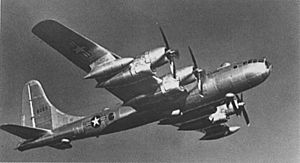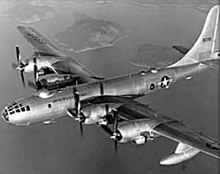Boeing B-50
| Boeing B-50 Superfortress | |
|---|---|
 Boeing B-50D "Superfortress" of the US Air Force |
|
| Type: | Strategic bomber |
| Design country: | |
| Manufacturer: | |
| First flight: |
June 25, 1947 |
| Commissioning: |
1948 |
| Production time: |
1947 to 1953 |
| Number of pieces: |
371 |
The Boeing B-50 Superfortress (Boeing Model 345-2) was a four-engine American long-range bomber . It was a direct further development of the B-29 Superfortress . Since it was supposed to carry a greater bomb load than the B-29, it was equipped with the much more powerful Pratt & Whitney R-4360 Wasp major radial engines . In addition, the new model received numerous detail improvements, such as a larger vertical stabilizer and a generally lighter airframe .
history
The US Air Force changed the originally used designation B-29D to B-50 in December 1945 , which was justified by the numerous modifications compared to the B-29. The renaming should also make it easier to move the US Congress to approve funds for the "novel" model.
The first production machine (B-50A / 46-002) took off for the first time on June 25, 1947 and showed a considerable increase in performance compared to the B-29.
Between 1947 and 1953 371 machines were built in many different versions. The most popular version was the B-50D , which could carry two 2650 liter external tanks. The last version built was the KB-50J , which carried two J47 jet engines in attachment containers. This enabled the top speed to be increased to up to 715 km / h.
The B-50 was used as a long - range nuclear-capable bomber and reconnaissance aircraft. From 1956 to 1958 she was also used for weather observation and for exploring hurricanes . In the Vietnam War she last served as aerial refueling tanker before it was decommissioned 1965th
In March 1949, was achieved with the Lucky Lady II with the US pilots Captain James G. Gallagher, the first non-stop - world flight in 94 hours from the Carswell Air Force Base in Texas with air refueling over the Azores, Saudi Arabia, the Philippines and Hawaii.
On July 29, 1953, an RB-50G of the 343th Strategic Reconnaissance Squadron of the US Air Force with 17 crew members on board two Soviet MiG-15 fighter aircraft with the pilots Rybakow and Jablonski was shot down over the Sea of Japan . Only copilot John E. Roche survived. Another RB-50G of the 41st Air Division also disappeared over the Sea of Japan on September 10, 1956 on a SIGINT mission. However, this aircraft was not shot down by Soviet planes, as was assumed for a long time, but most likely fell victim to Typhoon "Emma". The crew of sixteen is considered missing.
Some B-50s were later converted into tanker aircraft.
production
Acceptance of the B-50 by the USAF:
| version | 1947 | 1948 | 1949 | 1950 | 1951 | 1952 | 1953 | TOTAL | PRICE |
|---|---|---|---|---|---|---|---|---|---|
| B-50A | 3 | 73 | 3 | 79 | $ 1,144,296 | ||||
| B-50B | 45 | 45 | $ 1,144,296 | ||||||
| YB-50C | 1 | 1 | |||||||
| B-50D | 95 | 127 | 222 | $ 1,144,296 | |||||
| TB-50H | 22nd | 2 | 24 | $ 1,485,571 | |||||
| TOTAL | 3 | 73 | 144 | 127 | 0 | 22nd | 2 | 371 |
Conversion of the B-50:
| version | out | FY 1950 | FY 1951 | FY 1952 | FY 1953 | FY 1954 | FY 1955 | FY 1956 | FY 1957 | FY 1958 | FY 1959 | TOTAL | comment |
|---|---|---|---|---|---|---|---|---|---|---|---|---|---|
| RB-50 | B-50B | 28 | 16 | 44 | originally RB-50B, renamed 14 E, 14 F and 15 G in 1951, 1 loss | ||||||||
| RB-50F | RB-50E | 2 | 2 | ||||||||||
| RB-50D | B-50D | 2 | 2 | ||||||||||
| EB-50B | B-50B | 1 | 1 | ||||||||||
| TB-50A | B-50A | 11 | 5 | 16 | |||||||||
| TB-50B | B-50B | 1 | 1 | was probably the EB-50B | |||||||||
| TB-50D | B-50D, RB-50D | 11 | 6th | 2 | 1 | 20th | |||||||
| TB-50A, D | B-50A, D | 2 | 2 | either A or D | |||||||||
| TB-50G | RB-50G | 2 | 2 | ||||||||||
| WB-50D | B-50D | 42 | 32 | 74 | |||||||||
| KB-50 | B-50D, TB-50H | 10 | 72 | 49 | 131 | ||||||||
| KB-50D | B-50D | 3 | 3 | ||||||||||
| KB-50J | B-50D, KB-50 | 1 | 50 | 69 | 120 | ||||||||
| KB-50K | KB-50 | 7th | 17th | 24 | originally TB-50H | ||||||||
| TOTAL | 28 | 28 | 2 | 11 | 0 | 0 | 68 | 107 | 108 | 89 | 441 |
(FY = Fiscal Year, FY 1950 runs from July 1, 1949 to June 30, 1950)
The bombers were retired in 1955, the reconnaissance aircraft in 1960 and the training aircraft in 1959/60. The weather planes were in service until 1963/64, the tankers until 1964/65. The USAF lost 30 bombers from July 1, 1949 to June 30, 1955, 5 reconnaissance aircraft from July 1, 1951 to June 30, 1957, and 2 trainers from July 1, 1953 to June 30, 1957 in aircraft and ground accidents 1956, 7 weather planes from July 1, 1956 to June 30, 1961 and 25 tankers from July 1, 1956 to June 30, 1965.
Versions
- Boeing B-50A Superfortress
- Boeing B-50B Superfortress
- Boeing B-50C Superfortress
- Boeing B-50D Superfortress
- Boeing EB-50B Superfortress
- Boeing DB-50D Superfortress
- Boeing TB-50D Superfortress
- Boeing WB-50D Superfortress
- Boeing RB-50E Superfortress
- Boeing RB-50F Superfortress
- Boeing RB-50G Superfortress
- Boeing TB-50H Superfortress
- Boeing KB-50 Superfortress
- Boeing KB-50J Superfortress
- Boeing KB-50K Superfortress
Incidents
On November 10, 1950, a B-50A of the 64th Bombardement Squadron (43rd Bombardement Group, 15th Air Force ) lost a Mk. IV atomic bomb in the Saint Lawrence River near the Canadian city of Rivière-du-Loup . There was no detonation.
Technical specifications
| Parameter | Data of the B-50A |
|---|---|
| crew | 10-14 |
| span | 43.05 m |
| length | 30.18 m |
| height | 9.96 m |
| Max. Takeoff mass | 76,389 kg |
| drive | four Pratt & Whitney R-4360 Wasp-Major with 2,610 kW (3,500 hp) each |
| Top speed | 620 km / h |
| Summit height | 11,280 m |
| normal range | 7,483 km |
| Armament | twelve 12.7 mm machine guns in remote-controlled weapons stands, one 20 mm MK in the rear, 9,072 kg bombs |
Preserved machines
Today some machines still exist in various aviation museums, but none of them is in an airworthy condition.
See also
literature
- Marcelle Size Knaack: Post-World War II Bombers, 1945–1973. Office of Air Force History, Washington DC 1988.
- Peter M. Bowers: Boeing Aircraft Since 1916. 3rd edition. Naval Institute Press, Annapolis MD 1989, ISBN 0-87021-037-8 .
- Gordon Swanborough, Peter M. Bowers : United States Military Aircraft Since 1909. Smithsonian Institution Press, Washington DC 1989, ISBN 0-87474-880-1 .
Web links
Individual evidence
- ^ DPMO Cold War Incidents Report. (PDF; 64 KB) ( Memento from February 14, 2010 in the Internet Archive ).
- ^ Joachim Bashin, Ulrich Stulle: Hot Heaven in the Cold War. In: Flieger-Revue. Extra. No. 4, 2004, ISSN 2194-2641 , pp. 32-49, here p. 48
- ↑ Statistical Digest of the USAF 1947, p. 115; 1948II, p. 16; 1949, p. 164 f., 1951, p. 158; 1953, p. 187; 1958, p. 83 f.
- ↑ Statistical Digest of the USAF 1949-1965 , "USAF Aircraft Losses and Gains"; Size Knaack, Marcelle: Encyclopedia of US Air Force Aircraft and Missile Systems, Volume 2, Washington DC, 1978, pp. 161 ff.
- ^ John Clearwater: US Nuclear Weapons in Canada. Dundurn Press, Toronto et al. 1999, ISBN 1-55002-329-2 , p. 111.



